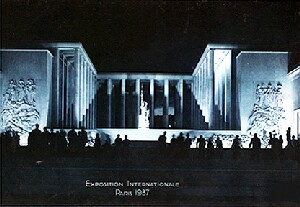|
1 |
 Copyright: |
|
1 |
 Copyright: |
The old Grand Palais erected for the 1900 World Exposition was only forty years later considered to be completely out of date because of its overdecorated neo-baroque style. The contemporary press was unanimous that this enormous building required a new facade to uphold its status amongst the assemblage of uncompromising neo-classical exhibition buildings. However, as is so often the case, inadequate funding stymied this ambitious plan. Only the interior design, primarily the enormous central hall used for galas, revues and banquets was completely reconstructed.
The Madeline, Lebout and Madelain architects team conceived a pure light architectural design in heavy Art Deco style: illuminated bands highlighted the cruciform shape of the hall decorated in the centre by a tear-shaped chandelier with a diameter of around 10 metres suspended in an illuminated circle. A main staircase crowned with a monumental sculpture embodying science was built to usher visitors into the new Palais de la Découverte galleries - but this entrance was never opened because of the numerous special events in the main hall (flower shows, balls, circuses, entertainments and car shows).
The plan to present the latest scientific discoveries in the Grand Palais was developed by Nobel laureate and under-secretary Jean Perrin in less than a year. The objective was to use exciting attractions and comprehensible learning aids to bring the latest scientific developments, from meteorology to nuclear physics, to a broader public. The exhibition was therefore not only designed by scientists and architects but also involved painters such as Fernand Léger who had published an article in 1935 on the convergence of art and science - his contribution was a decorative wall painting symbolising the transfer of forces. The architects were mainly concerned with fully concentrating the attention of the visitors on the technical gadgetry. One of their creations was the demonstration of electrostatic effects in the domed hall which was completely bathed in a mysterious blue light:
The twin building complex - the Museums of Modern Art
Because the French national collection of modern art was only very inadequately housed in the Palais du Luxembourg orangery, and the Paris municipal collection in the Petit Palais was also suffering from lack of space, the national and municipal governments decided to construct the long planned new museum buildings as an integral part of the World Exposition.
A design competition for the Museums of Modern Art was held in 1934 to find a solution to locating two separate buildings - one containing the national collection and the other the Paris municipal collection - on a trapezoid plot on the banks of the Seine.
Whilst numerous designs by internationally famous architects such as Le Corbusier, Garnier, and Mallet-Stevens were turned down, the commission decided in favour of the joint project submitted by J.-C. Dondel, A. Aubert, P. Viard and M. Dastugue. The group created a neo-classical complex split into two axis-symmetrical buildings connected at the front by an elevated open colonnaded square, and both opening at the other end towards the river with quarter cycle curves. The centre was occupied by a large sculpture-flanked ornamental pool. The high windowless lateral walls of the peristyle were decorated by large flat reliefs designed by Alfred Janniot reflecting the power of land and sea. The vertical accentuation via the rows of columns was continued in the tall narrow windows in the walls of the exhibition buildings facing the central square. Comb-like lateral wings with elevated windows were connected to the outward-facing walls of the main buildings.
| Year: 1937 | City: Paris | Country: France |
| Duration: 25th May - 25th November 1937 | ||